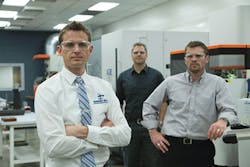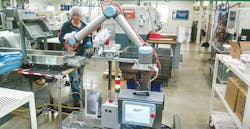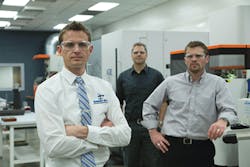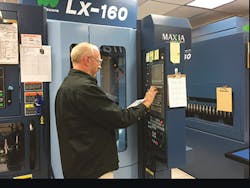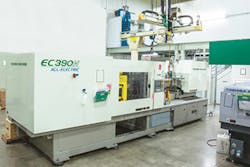Every end market has unique challenges for plastics processors, but none more so than the medical industry.
To earn new business, an injection molder must commit presses, auxiliary equipment, robots and even production staff to a project that might get delayed due to regulatory issues or early sales that are below projections. It takes a lot of faith.
"It's all just part of the business," said Joe McGillivray, CEO of Dynamic Group in Ramsey, Minn., a mold maker and injection molding company focused on the medical industry.
"We know that the product a medical company produces is probably going to be produced for a long time. It is probably something they plan on running 5, 6 or 7 years," he said. "So production volumes may start low, keep going up, and the job sticks around for a long time."
Dynamic specializes in building molds for small, precise, complex parts for the medical industry and in molding those types of parts. There is synergy between the two portions of the business.
Started as a mold maker
Dynamic Engineering was launched in 1977 by toolmakers Dave Kalina and Peter McGillivray. The two entrepreneurs slowly built their business and never shied away from investing in new technology if it made good business sense. Dynamic Engineering had some of the first sinker and wire electrical discharge machines (EDM) used by mold makers anywhere.
The company developed a reputation for making difficult-to-build, tight-tolerance, high-precision molds.
The partners visited a tool shop in Switzerland in the early 1990s that had its own molding facility. From that visit, they decided to launch a separate injection molding business they named Dyna-Plast. The two businesses were merged in 2008 and renamed Dynamic Group.
Today, annual sales are about $15 million, split evenly between the mold making and injection molding businesses. There are 120 employees in two plants about 10 miles apart.
David Kalina and Peter McGillivray took titles as directors last year and are currently overseeing the transition of Dynamic's leadership to their sons. Joe McGillivray is now CEO. Steve and Brian Kalina are president and VP of operations, respectively. The three sons now run day-to-day operations.
All three sons started as teenagers doing jobs such as sweeping floors, cleaning toilets and pulling weeds. After high school, they took distinctly different paths. Brian became a tool maker, returning to Dynamic shortly after finishing school. Joe went to college and worked outside the plastics industry before returning. Steve worked with other injection molders before joining the Marine Corps and then returning to Dynamic.
Injection molding
Dynamic has 17 presses, ranging from 25 tons to 390 tons. Most of the parts they produce are smaller than the size of a fist, according to Steve Kalina. Typically, they are components of medical devices and some are subassemblies, all molded with engineering grade materials.
"We don't get into commodity products," Steve Kalina said. "We do a lot of small, complex parts in low-to-mid volumes and bridge production volumes, up to 300,000 to a half-million parts.
"We have some parts that we have been producing for 15 years to 17 years," he said. "Our oldest internal mold has been running since 1997 and is still in production."
The 17 presses represent five brands. The horizontal presses are from Wittmann Battenfeld, Toshiba and Milacron LLC, while the vertical molding machines are from Nissei. All except the older Wittmann Battenfelds are all-electric machines.
The company took delivery of its first Arburg in December, a 110-ton Allrounder. The goal is for all horizontal machines to eventually be from two brands — Arburg and Toshiba.
The same strategy is being followed for auxiliary equipment. "For heaters and chillers, we want to stay with two vendors," Steve Kalina said. "The key factor for selecting the two vendors is their ability to service us."
The current heaters are from Advantage Engineering and Sterling, and the dryers are from Novatec and Conair.
A centralized materials control system is being considered.
The company hired a director of quality and engineering in November and one of her responsibilities is to validate the capabilities of new technology and new vendors of both injection molding and mold making equipment.
"There are several cutting-edge injection molding technologies we are considering, having to do with material melt and injection, as well as other things," Steve Kalina said. "That is going to be a big part of how we move forward."
Dynamic recently added in-house isopropyl alcohol cleaning capability for the parts it molds. Previously, parts were sent to an outside vendor for cleaning before coming back for secondary operations or to be packaged. Turnaround was about three weeks. Now the parts can be cleaned the same day they are molded.
"We were able to reduce cleaning costs and pass along the savings to our customers," Joe McGillivray said.
Automation
The company has moved away from typical gantry-style robots designed to reduce labor and achieve higher volumes and faster cycle times. "With lower-volume work, we did not really have a need for that," Steve Kalina said.
The company purchased three collaborative robots, also known as cobots, from Universal Robots USA Inc., Ann Arbor, Mich. The models are the UR5, with a payload of up to 11 pounds and a reach radius of 33.5 inches, and the UR10, with a payload of up to 22 pounds and reach radius of 51 inches.
"The automation we are focusing on now is to take away tasks that are not much fun or challenging," Steve Kalina said. "As we grow, we need to have the capacity to take on more of these low-volume programs. As it gets tougher to find capable people and to compete wage-wise, we are trying to find ways to make our people's jobs more fulfilling."
During PMM's visit, an operator and robot worked side-by-side at a 75-ton Nissei press molding a tiny catheter part. From behind, it looked like two people instead of a person and a cobot.
In another recent experience with the robots, a Y-manifold molding project required three or four people and acceptable parts could be made only about four hours per day, according to Joe McGillivray. Now, with just one person doing the more interesting tasks and the cobot handling the monotonous work, significantly more parts can be made each shift and it is possible to run the operation during all three shifts.
"The way we want this to unfold is we purchase a robot, hire an engineer to integrate robots and increase overall production capacity," Joe McGillivray said. "When we sell that new capacity, we can hire more people companywide."
An automation engineer was hired in 2015.
The new Arburg press is being installed in a fully automated work cell. It will include a standard picker robot from a manufacturer yet to be selected that can hand the part over to the cobot for secondary operations. Steve Kalina said the cobot works especially well as part of an ultrasonic degating process.
Dynamic Group has molding and assembly in a Class 7/10,000 clean room. Its insert molding and overmolding business is growing, and it offers other services, including final packaging. The molding facility is ISO 13485-, ISO 9001- and FDA-certified for producing medical products.
Ultrasonic welding equipment from Dukane Corp., St. Charles, Ill., and Branson Ultrasonics Corp., Danbury, Conn., a division of Emerson, are both used.
Mold making
Approximately 15 percent of the tools manufactured by Dynamic go to in-house plastic injection molding projects.
During the past five years, Dynamic's toolmaking business has dramatically shifted to molds for metal injection molding (MIM). Molds for MIM are all sold to outside customers.
"This has enhanced our capabilities to make molds for plastics because tools for metal injection molding require much tighter tolerances," Steve Kalina said.
Dynamic has also inherited plastic tooling programs when other shops could not meet tight-tolerance requirements. "That quality is inherent in our tool shop," Steve Kalina said.
An example is a Y-manifold part with tiny cores and very delicate shut-offs that can take up to 40,000 pounds per square inch of pressure when molded.
Molds for medical and dental products make up most of Dynamics' molds. There are also some in the firearms and consumer products areas.
Dynamic has six machining centers from Makino, Mason, Ohio, as well as equipment from GF Machining Solutions, Lincolnshire, Ill., and Japanese manufacturer Matsuura Machinery Corp., represented in the U.S. by Matsuura Machinery USA Inc., St. Paul, Minn.
"Makino is one of the few machining center manufacturers that focuses on injection mold production," Steve Kalina said. "They understand exactly what we need and the longevity of their equipment is incredible. We have two SNC 106s verticals we have been using for more than 20 years. They just keep working."
Dynamic recently purchased two LX-160 five-axis, high-speed Matsuura machining centers to accommodate large orders for very tight-tolerance dental bracket molds. Before buying, Dynamic had several manufacturers produce samples.
"We found that the technology is getting so advanced that it is difficult to validate the manufacturers' claims," Joe McGillivray said. "Some claim to be repeatable in the sub-micron range, and validating something like that is not easy."
To validate the accuracy claims, Dynamic purchased a 3-D visual scanning device from Keyence Corp. of America, Itasca, Ill., that uses structured lighting to collect hundreds of thousands of data points in a few seconds. The data from the scan is imported into special metrology software and compared to a CAD database.
The Keyence system that Dynamic bought was one of the first sold in the U.S., according to Joe McGillivray.
"It quickly told us that our two top vendors had very similar quality," he said.
Other uses have been found for the Keyence system. "We are ready to take the next step and integrate a 3-D inspection system in a production line," Joe McGillivray said.
Steve Kalina said the cutting-edge toolmaking equipment helps recruit and retain toolmakers.
"Toolmakers want to be challenged and to work with the newest equipment and technologies. That is the passion of most toolmakers," he said.
The company has five full-time mold designers, and a senior toolmaker works directly with the designers. Sixty toolmakers and machinists are involved in mold making. The company's technology appeals to Dynamic's other workers, as well.
"A lot of our [press] operators come in as entry-level employees without experience in the plastics industry. For them to sit side-by-side with a robot and to help operate that robot brings a level of excitement to their job," Steve Kalina said.
What's in the future?
After years of steady growth, members of the second-generation of leadership believe the momentum is shifting toward faster growth. "We are getting face-to-face with potential customers more often now and new projects are coming in the door," Steve Kalina said. "We expect exponential growth going forward."
The management team has been implementing EOS/Traction during the past year. It is a well-documented system designed to instill focus, discipline and accountability in the company so that everyone shares a common vision. Improvements throughout the plant are continuously identified, implemented and tracked.
The strategy to look for opportunities to improve operations with automation is also part of Dynamic's growth plan. "It also makes us a stronger company along the way," Steve Kalina said.
Dynamic has a robust apprenticeship program for toolmakers that has drawn some top students and quickly helped them develop into key contributors. This is crucial for Dynamic's growth in the tooling industry, Steve Kalina said.
The company also uses training programs from Paulson Training Programs Inc., Chester, Conn., at its molding facility. It plans to expand these programs and the apprenticeships to create "Dynamic University," making training available to every person in the company. "We know we have to compete with a lot of companies to get the top employees," Steve Kalina said.
"For a company our size, we spend more time and effort on research than our competition. We believe that is vitally important for a small business because of the pace of change today."
The focus will stay on medical products, but Joe McGillivray believes the molding business will grow faster than tool making. He said some nonmedical parts that Dynamic was molding but that did not need to be molded in a medical facility have been replaced with parts that fit Dynamic's focus.
"We are filling that capacity back up, and it is a better balance for us and the revenue stream is more consistent," he said.
Ron Shinn, editor
Contact:
Dynamic Group, 763-780-8674, www.dynamicgroup.com
About the Author
Ron Shinn
Editor
Editor Ron Shinn is a co-founder of Plastics Machinery & Manufacturing and has been covering the plastics industry for more than 35 years. He leads the editorial team, directs coverage and sets the editorial calendar. He also writes features, including the Talking Points column and On the Factory Floor, and covers recycling and sustainability for PMM and Plastics Recycling.
